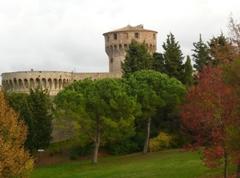You are here: Who we are > City history
City history
Water
An ancestral heritage of Volterra, viewed from the top of the hill glistening Mediterranean blue.
When the water receded millions of years ago it left a valuable resource to the ancient city of Volterra: salt. A source of wealth which would be worth the price of oil today.
Fortifications, fortresses and castles were erected to control and protect the sites where the brine was extracted. A few secluded mysterious remains can still be admired today such as the Rocca Sillana in Pomarance where the battle between Mario and Sulla (Silla in Italian, hence the name) supposedly took place and the Rocca di Montegemoli that dominates the area of Saline.
There was even a salt road- La Salaiola- where the salt was transported from Saline di Volterra through the Era valley to Castelfiorentino, Fiesole along the Padana valley to Salzburg and the Baltic coast.
The numerous fresh limpid water springs with healing properties were once a valuable asset to Volterra. There are two absolutely charming sites: the fountains of San Felice and Docciola.
Water also bequeathed alabaster to Volterra. A stone that has been extracted, manipulated and carved since the Etruscan era. This rock made up of tiny crystals of chalk brought employment and wealth to Volterra.
The town is still renowned for its alabaster workshops. The first alabaster school-workshop was founded at the beginning of the 18th century by a young Volterran aristocrat, Marcello Inghirami, and by the end of the century Volterra boasted international repute. Alabaster artefacts, skilfully and imaginatively created by local artisans, were sold all over the world. The Palazzo Incontri which commemorates this splendid epoch became Palazzo Viti in 1850 when Benedetto Viti returned from his alabaster expedition to the United states, China and India.
The alabaster craft is an extraordinary art begun by the ancient Etruscans . A rich collection of magnificently carved cinerary urns can still be admired in the Guarnacci museum,one of the most important places to visit in Volterra.
Salt, alabaster, tokens of water to this earth-toned city.







